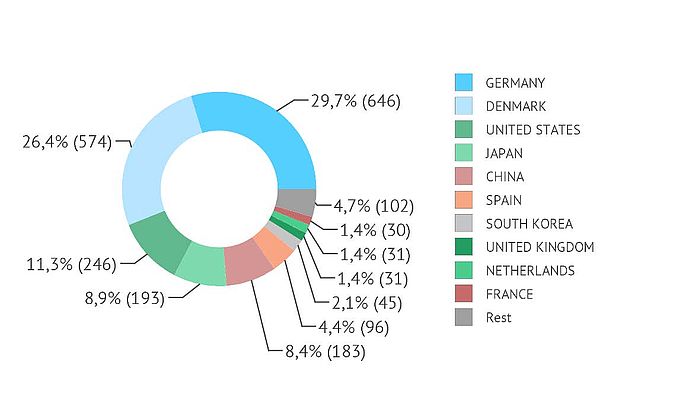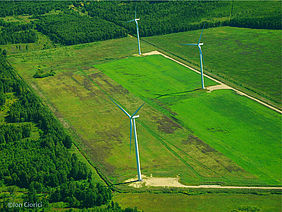The present review includes key indicators of patenting activity of inventors in the field of wind energy in 2017. 2171 patent applications with technical content related to horizontal axis wind turbines registered in 28 patent offices around the world during the year under consideration were collected for the analysis. More than four hundred applicants from 29 countries participated in the patenting process. The methodology of searching and processing patent documents is provided on the Advanced Energy Technologies website.
About 50% of the total number of patent applications were registered in three patent offices in nearly equal shares – USPTO (US), EPO (Europe), and CNIPA (CN). Also, the most popular countries for patenting were Brazil, Japan, Canada, Germany, South Korea, Russia, and WIPO international patent office. The rest of the world accounted for a little under 8%.
Distribution of patent applications, published by the top 10 patent offices
| Office | 2017 | Share of total, % |
|---|---|---|
| United States Patent and Trademark Office | 386 | 17.78 |
| European Patent Office | 369 | 16.99 |
| State Intellectual Property Office, China | 357 | 16.44 |
| World Intellectual Property Organization | 289 | 13.31 |
| National Institute of Industrial Property, Brazil | 195 | 8.98 |
| Japan Patent Office | 138 | 6.36 |
| Canadian Intellectual Property Office | 85 | 3.92 |
| German Patent and Trade Mark Office | 70 | 3.22 |
| Korean Intellectual Property Office, South Korea | 70 | 3.22 |
| Rest Of World | 170 | 7.83 |
| Grand Total | 2 171 | 100 |
Source: Advanced Energy Technologies
Non-resident share in the patent offices of Brazil, Canada, and Russia was close to 100%. In USPTO (US), EPO, and CNIPA (CN) the share of non-residents among the applicants was 73%, 29%, and 63%, respectively. Also, the USPTO (US) was the most popular patent office with non-resident applicants in terms of geographical diversity. Representatives of 19 countries of the world have registered their applications there in 2017. The residents of the European countries were dominating among applicants with the aggregate share of patent applications exceeding 65%. This year's unconditional leaders were the representatives of Germany (nearly 30% of applications) and Denmark (more than 26% of applications). The residents of the USA, Japan and China in total registered 28.6% of documents, nearly 10% each. In 2017 the representatives of the aforementioned five countries in total submitted nearly 85% of all new patent applications.
Distribution of countries of the world by the number of resident applicants in patent applications
Source: Advanced Energy Technologies
A little more than a thousand of individual IPC subgroups were mentioned in the patent applications collected, while in total they were assigned 5624 times. The most popular among them were: F03D 1/06 (rotors) – met in 12.4% of applications; F03D 07/02 (the wind motors having rotation axis substantially parallel to the air flow entering the rotor) – 7.2%; and F03D 07/04 (Automatic control; Regulation) – 4.3%.
Among the technology elements that were disclosed in the inventions Control and safety systems, and Blades and components thereof raised the most interest with the inventors. Only in several applications addressed the issues of Energy storage and hybrid generation systems, and Aerodynamic casings.
Distribution of patent applications by the number of technology elements mentions

Source: Advanced Energy Technologies
AC - Aerodynamic casings (nacelles, shrouds, etc.); B - Blades and components thereof; CSS - Control and safety systems; EE - Electrical equipment and generators; ESH - Energy storage and hybrid generation systems; GT - Gearbox and transmission; MRR - Maintenance, repair and replacement; OTE - Other technology elements; R - Rotors and components thereof; SE - Structural elements
The most acute problems the majority of the proposed technical solutions were aimed at were the problems related to maintenance, repair and replacement of wind turbine elements (High OPEX / Repair and replacement, and High OPEX / Operational maintenance). These problems were mentioned in the patent documents in more than 35% of the total number of times any problem was mentioned. Also, the inventors fairly often addressed their ideas to resolve the issues related to High CAPEX / Equipment production, High CAPEX / Plant construction, and Low efficiency of secondary equipment. In 2.5% of cases the exact determination of problems in the inventions was unsuccessful.
Distribution of technical problems in the patent applications found
| Problem | Average rating | Share, % | Total 2017 |
|---|---|---|---|
| Administrative and organisational problems | 10 | 2 | 59 |
| Environmental and social impact | 10 | 6.4 | 188 |
| High CAPEX / Plant construction | 10 | 12.5 | 365 |
| High costs in general | 8 | 0.5 | 14 |
| High CAPEX / Equipment production | 10 | 15.1 | 443 |
| High OPEX / Operational maintenance | 10 | 10.4 | 306 |
| High OPEX / Repair and replacement | 10 | 26.2 | 767 |
| Low efficiency in general | 12 | 1.2 | 36 |
| Low kinetic-to-mechanical power conversion efficiency | 9 | 4.8 | 141 |
| Low mechanical-to-electric power conversion efficiency | 9 | 1.6 | 47 |
| Low efficiency caused by secondary natural factors | 9 | 4.4 | 129 |
| Low efficiency of secondary equipment | 9 | 11.3 | 330 |
| Low efficiency caused by wind variability | 8 | 1 | 30 |
| Unclear problem | 9 | 2.5 | 74 |
Source: Advanced Energy Technologies
More detailed information on the methodology as well as on the results of patent researches in the most important fields of contemporary energy industry can be found at Advanced Energy Technologies.
